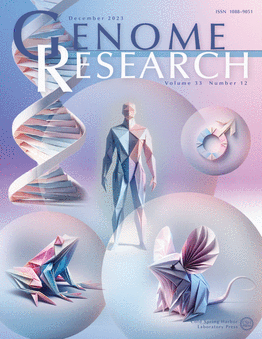马拉维湖慈鲷基因组图谱揭示了由转座元件驱动的广泛结构变异
IF 6.2
2区 生物学
Q1 BIOCHEMISTRY & MOLECULAR BIOLOGY
引用次数: 0
摘要
泛基因组学方法有可能发现迄今为止尚未发现的参考基因组中缺失的序列,使其对研究不同生物的进化和物种形成过程有用。东非裂谷湖的慈鲷是自然界最具表型多样性的脊椎动物辐射之一,但基于单核苷酸多态性(SNP)的研究显示,马拉维湖物种之间的序列差异很小,配对差异为0.1%-0.25%。这些研究是基于将短读数与单一线性参考基因组比对,而忽略了大规模结构变异(SVs)的贡献。我们构建了一个泛基因组图,整合了六个新的和两个现有的马拉维湖单色胺慈鲷的长读基因组组合。该图直观地表示了基因组之间复杂和嵌套的变异,并揭示了SV景观由大插入主导,许多插入只属于单个组装。该图包含了7个物种的大量额外序列,其总长度比单个慈鲷基因组长33.1%。大约4.73%至9.86%的组装长度被估计为慈鲷之间的种间结构差异,表明SNP研究未充分认识到大量的基因组多样性。尽管编码区仍然高度保守,但我们的分析发现SV序列中有很大一部分是转座元件(TE)插入,特别是DNA、LINE和LTR TE。这些发现强调了慈鲷基因组是由小核苷酸突变和大的te衍生序列改变形成的,这两者都值得研究,以了解它们在慈鲷进化中的相互作用。本文章由计算机程序翻译,如有差异,请以英文原文为准。
Lake Malawi cichlid pangenome graph reveals extensive structural variation driven by transposable elements
Pangenome methods have the potential to uncover hitherto undiscovered sequences missing from established reference genomes, making them useful to study evolutionary and speciation processes in diverse organisms. The cichlid fishes of the East African Rift Lakes represent one of nature's most phenotypically diverse vertebrate radiations, but single-nucleotide polymorphism (SNP)–based studies have revealed little sequence difference, with 0.1%–0.25% pairwise divergence between Lake Malawi species. These were based on aligning short reads to a single linear reference genome and ignored the contribution of larger-scale structural variants (SVs). We constructed a pangenome graph that integrates six new and two existing long-read genome assemblies of Lake Malawi haplochromine cichlids. This graph intuitively represents complex and nested variation between the genomes and reveals that the SV landscape is dominated by large insertions, many exclusive to individual assemblies. The graph incorporates a substantial amount of extra sequence across seven species, the total size of which is 33.1% longer than that of a single cichlid genome. Approximately 4.73% to 9.86% of the assembly lengths are estimated as interspecies structural variation between cichlids, suggesting substantial genomic diversity underappreciated in SNP studies. Although coding regions remain highly conserved, our analysis uncovers a significant proportion of SV sequences as transposable element (TE) insertions, especially DNA, LINE, and LTR TEs. These findings underscore that the cichlid genome is shaped both by small-nucleotide mutations and large, TE-derived sequence alterations, both of which merit study to understand their interplay in cichlid evolution.
求助全文
通过发布文献求助,成功后即可免费获取论文全文。
去求助
来源期刊

Genome research
生物-生化与分子生物学
CiteScore
12.40
自引率
1.40%
发文量
140
审稿时长
6 months
期刊介绍:
Launched in 1995, Genome Research is an international, continuously published, peer-reviewed journal that focuses on research that provides novel insights into the genome biology of all organisms, including advances in genomic medicine.
Among the topics considered by the journal are genome structure and function, comparative genomics, molecular evolution, genome-scale quantitative and population genetics, proteomics, epigenomics, and systems biology. The journal also features exciting gene discoveries and reports of cutting-edge computational biology and high-throughput methodologies.
New data in these areas are published as research papers, or methods and resource reports that provide novel information on technologies or tools that will be of interest to a broad readership. Complete data sets are presented electronically on the journal''s web site where appropriate. The journal also provides Reviews, Perspectives, and Insight/Outlook articles, which present commentary on the latest advances published both here and elsewhere, placing such progress in its broader biological context.
 求助内容:
求助内容: 应助结果提醒方式:
应助结果提醒方式:


